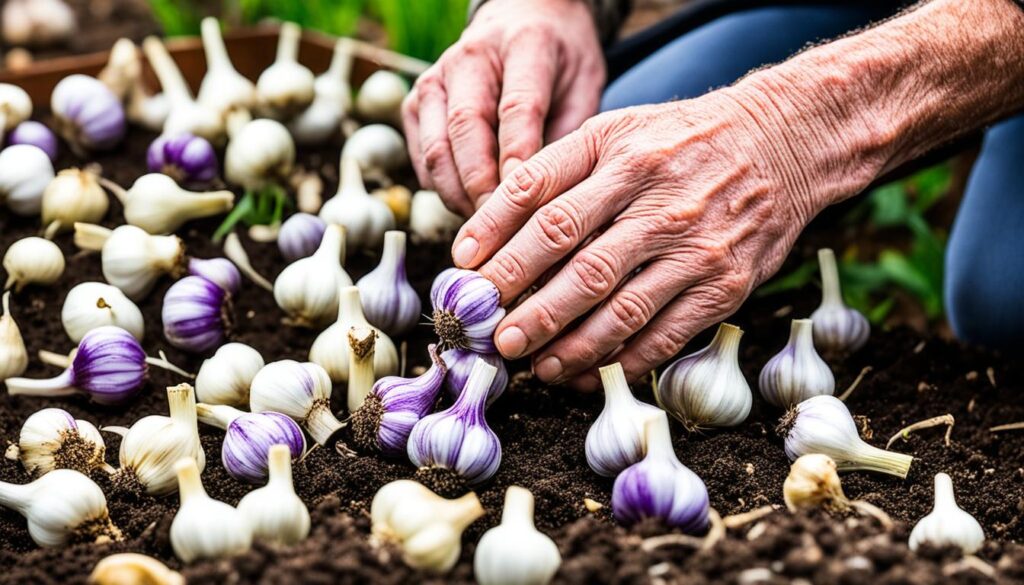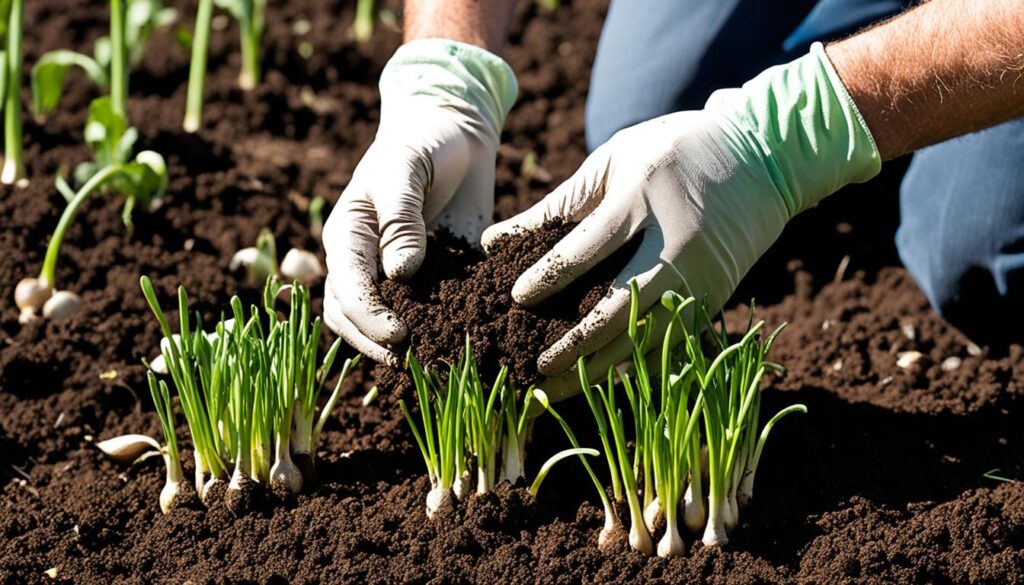Growing Garlic: How to Plant Garlic Successfully
Are you ready for a tasty gardening journey? Garlic is key in many foods and is full of health benefits. It makes dishes taste great and helps fight off sickness. Plus, one clove can grow into many cloves.
This guide will show you how to grow garlic at home. It’s great for both new and experienced gardeners. Follow our easy steps and tips for a big garlic harvest.
Key Takeaways:
- Garlic is not just a culinary delight, but it also offers numerous health benefits.
- A single clove of garlic has the potential to yield an entire harvest of cloves.
- In this guide, we will provide step-by-step instructions for planting and caring for garlic plants.
- Learn about timing, soil preparation, watering, and harvesting techniques to ensure optimal growth.
- Discover troubleshooting tips and expand your knowledge of companion planting with garlic.
Selecting the Right Garlic Bulbs
Before you start planting garlic, it’s important to choose the right bulbs. The quality of the bulbs you pick will affect your garlic crop’s success and health. Here are some tips for picking the best garlic bulbs:
- Choose certified organic bulbs: Look for bulbs that are certified organic. These bulbs are grown without synthetic pesticides or chemicals. This means you start with healthy, natural bulbs.
- Inspect for firmness and size: Press the bulbs gently to check for firmness. Healthy bulbs should feel solid. Pick bulbs that are medium to large in size. Avoid small or shriveled ones as they might not grow well.
- Consider the variety: There are many garlic varieties, each with its own flavor and growing traits. Research and pick the one that fits your taste and growing conditions. Popular varieties include Rocambole, Porcelain, and Artichoke garlic.
- Look for cloves with uniform color: Check the cloves inside the bulb. They should all be the same color and free from mold or discoloration. This means they’re of good quality and will grow well.
- Source bulbs from reputable suppliers: Buy your garlic bulbs from trusted suppliers or nurseries. This way, you get high-quality bulbs that have been stored and handled right. It increases your chances of success.
Choosing the right garlic bulbs sets you up for success in growing garlic. Make sure to pick bulbs that are certified organic, firm, and the right size. Think about the variety you like best and check that the cloves are all the same color. Always buy from reputable suppliers. These steps will help you have a great garlic harvest.

Preparing the Soil for Planting
Getting the soil ready is key to growing garlic well. It helps your garlic plants grow strong and give a big harvest. Here are some important steps for preparing the soil.
1. Choose a Well-Drained Location
Garlic likes soil that drains well to avoid waterlogging and root rot. Pick a spot in your garden that drains well. Or make raised beds if your soil holds too much water.
2. Test and Adjust Soil pH
Garlic does best in slightly acidic soil, with a pH of 6.0 to 7.5. Test your soil’s pH and fix it if needed. Add compost or manure to make it less acidic. Use sulfur or peat moss to make it more acidic.
3. Clear the Area and Remove Weeds
Before planting garlic, get rid of weeds and unwanted plants. Weeds take nutrients and water from garlic. Use a hoe or pull them out by hand to remove them completely.
4. Loosen the Soil
Garlic bulbs need soil that’s loose for growth and roots. Dig the soil with a fork or tiller to 8 to 10 inches deep. This makes the soil fine for roots to grow and helps the plants stay healthy.
5. Incorporate Organic Matter
Add organic stuff to the soil to make it richer. This gives your garlic the nutrients it needs and makes the soil better. Mix in compost or manure well into the soil.
6. Level the Soil Surface
After adding organic stuff, make the soil level. Get rid of big clumps or debris. This lets garlic cloves grow well in contact with the soil.
7. Consider Mulching
Mulching keeps soil moist and stops weeds. Put a layer of organic mulch, like straw or leaves, over the garlic plants after planting. It also keeps soil temperature right and protects bulbs in winter.
By doing these things, you’ll make the best place for planting garlic. This will help your garlic grow well.
| Soil Preparation Techniques | Benefits |
|---|---|
| Choosing a well-drained location | Prevents waterlogging and root rot |
| Testing and adjusting soil pH | Promotes optimal growth and nutrient absorption |
| Clearing the area and removing weeds | Eliminates competition for nutrients and moisture |
| Loosening the soil | Allows for root penetration and proper plant development |
| Incorporating organic matter | Improves soil fertility and structure |
| Leveling the soil surface | Ensures proper contact between soil and garlic cloves |
| Considering mulching | Retains moisture, suppresses weeds, and regulates soil temperature |

“Proper soil preparation is the foundation of successful garlic cultivation.” – Gardening Expert
Timing and Seasonality
Knowing when to plant garlic is key for its growth. Picking the best time to plant can make your garlic bulbs grow better.
Garlic loves cool weather and needs cold to form bulbs. Plant garlic in the fall, before the ground freezes.
For most places, plant garlic in late September or early October. This lets the bulbs grow strong roots before winter.
The best time can change based on where you live and the weather. Look at your area’s frost dates and temperature to pick the right time.
Plant garlic cloves in good soil, two inches deep, and six inches apart. Make sure the pointed ends face up. This way, they get enough air and stay healthy.
After planting, garlic goes dormant in winter. The cold helps the roots grow and gets the bulbs ready for spring.
In spring, garlic starts growing again, showing green shoots. Keep it watered and weed-free to help it grow well.
With careful timing and attention, you can make the most of your garlic planting season. Enjoy a big harvest of tasty, aromatic garlic bulbs.
Did you know?
Garlic planting season changes with the climate and location. In warm places with mild winters, plant garlic in early spring. But in cold areas, fall planting works best for bulb growth.
Planting Garlic Bulbs
Now that the soil is ready, it’s time to plant your garlic bulbs. Here are the steps to follow for a successful harvest:
- Choose the right bulbs: Pick healthy garlic bulbs from a trusted source. Make sure they are firm, plump, and without damage or disease.
- Prepare the planting bed: Remove weeds and debris from the bed. It should drain well. Garlic likes loose, rich soil. Add compost or manure if needed.
- Break up the bulbs: Before planting, split the garlic bulbs into individual cloves. Keep the papery skin on each one.
- Choose the right spacing: Plant cloves 6 inches apart, with rows 12 inches apart. This lets each plant get enough sunlight, nutrients, and air.
- Plant the cloves: Dig a hole or trench 2 inches deep. Put a garlic clove in it with the pointy end up and the base down. Space them as directed.
- Cover and mulch: Cover the cloves with soil, making sure they’re fully buried. Then, add organic mulch like straw or wood chips to keep moisture in and weeds out.
- Water thoroughly: Water the garlic bed well after planting. This helps roots grow. Keep it moist during the growing season, especially when it’s dry.
- Monitor and protect: Watch for pests or diseases and act fast to protect your garlic. Mulching and weeding help keep the area clean and promote healthy growth.
With your garlic bulbs in the ground, you’re set for a great harvest. Next, we’ll talk about how to care for your garlic plants to keep them healthy and thriving.
Caring for Garlic Plants
Proper care is key for garlic plants to grow well and produce healthy bulbs. Follow these tips to keep your plants healthy throughout their life.
1. Watering:
Garlic needs regular water to grow strong roots and leaves. Water deeply to reach the roots. But don’t overwater, as it can cause rot.
Check the soil often and water when it feels dry. Garlic likes the soil to be moist but not soaked.
2. Mulching:
Mulching keeps the soil moist, stops weeds, and controls temperature. Use organic mulch like straw or leaves around your garlic. It keeps moisture in and weeds out.
Mulch also keeps the bulbs safe from extreme heat or cold.
3. Fertilizing:
Garlic grows better with regular food. Before planting, add organic stuff like compost to the soil. During the season, use a balanced or slow-release fertilizer as the package says.
Avoid too much nitrogen, as it makes leaves grow too much and can hurt bulb size.
4. Pest and Disease Prevention:
Keep your garlic safe from pests and diseases by staying clean in the garden. Pull weeds often to stop pests from hiding. Check the plants for pests like aphids and use safe pest control if you find any.
Diseases like white rot and downy mildew can hit garlic. Keep plants far apart for better air flow. Don’t water from above to avoid fungal infections. If you see disease, take out the sick plants right away.
5. Harvesting Scapes:
Garlic scapes are the curly stalks that grow from the plants. Cut them off when they curl and before the flowers open. Use scapes in cooking for a mild garlic taste.
By following these tips and taking good care of your garlic, you’ll get lots of tasty bulbs.
Managing Weeds
Managing weeds is key to growing garlic well. Weeds can take over your garlic beds, taking nutrients and water from your plants. To help your garlic grow strong and produce well, you need good weed management.
Start by preparing the soil well. Clear the area of weeds and make sure the soil has no weed seeds. This lets your garlic grow better.
Using mulch can also help stop weeds. Put organic mulch like straw or wood chips around your garlic. It stops weed seeds from growing and keeps the soil moist and cool, perfect for garlic.
Regularly check your garlic for weeds. Pull weeds by hand or use a small hoe. This keeps your garlic beds weed-free without hurting your plants.
For big areas, use a wheel hoe to weed. These tools work fast and save you time. But, be careful not to harm your garlic.
Organic herbicides can also control weeds. They don’t harm your garlic. But, always follow the instructions to use them safely.
Keeping your garlic beds weed-free is vital. Use strategies like good soil prep, mulching, regular weeding, and organic herbicides. This helps your garlic grow and produce well.
Watering and Irrigation
Proper watering is key for garlic plants to grow well. Follow these garlic planting tips to make sure your plants get enough water.
Watering Schedule
Garlic plants need a lot of water when they’re young. Keep the soil moist but not too wet. Water them often, aiming for about 1 inch of water each week.
This can change based on your area and soil type. Check the soil often to avoid giving too much or too little water.
Time of Day
Water your garlic in the morning. This lets the leaves dry out during the day, which helps prevent diseases. Don’t water in the evening because it can lead to diseases.
Watering Technique
When watering, focus on the roots, not the leaves. Water at the base of the plants to make sure the roots get enough moisture. Drip irrigation or soaker hoses are great for watering the roots without getting the leaves wet.
Water Quality
Garlic likes soil that drains well and is neutral in pH. If your soil holds water too much, it can cause root rot. Add organic matter to the soil to help it drain better.
If your water is hard, it can also harm your plants. Use rainwater or filtered water to avoid this problem.
| Signs of Underwatering | Signs of Overwatering |
|---|---|
|
|
Pay attention to your garlic’s watering needs and follow these garlic planting tips. This will help your plants grow well and give you a big harvest.
Harvesting Garlic
When your garlic plants are ready, it’s time to pick them. Picking at the right time gives you the best taste and keeps the garlic fresh. Here’s how to pick your garlic and enjoy your hard work.
Signs of Readiness
Before you pick, check for signs that your garlic is ready. Look for these things:
- Yellowing leaves: The lower leaves will turn yellow and dry up as the garlic gets ready. This means it’s almost time to pick.
- Fallen over foliage: If more than half of the garlic leaves fall over, the bulbs are big enough to pick.
- Tight bulb wrappers: Remove some soil around the garlic plant. If the bulb wrappers are tight and not open, it’s ready to be picked.
Remember, different garlic types grow at different times. Knowing your garlic type helps you know when to pick.
Harvesting Techniques
Here’s how to pick your garlic right:
- Loosen the soil: Use a fork or shovel to gently loosen the soil around the garlic. Be careful not to hurt the bulbs.
- Lift the bulbs: Carefully lift the garlic bulbs with your hands or a fork. Don’t pull hard, or you might damage them.
- Brush off excess soil: After lifting, brush off any extra soil. Make sure not to touch the bulb wrappers or harm the cloves.
Curing Garlic
After picking, curing your garlic is key to keeping it tasty and fresh. Here’s how:
- Trim the roots and foliage: Cut the roots and leaves with scissors or pruners. Keep about an inch of stem on the bulb.
- Provide good airflow: Lay the bulbs in a dry place where air can move freely. Make sure they’re not too close together.
- Avoid direct sunlight: Keep the garlic in the shade to stop it from drying out or getting bad flavors.
- Allow curing: Let the garlic cure for 2-4 weeks. This makes the outer layers dry and the flavors stronger.
Once cured, trim the leaves, clean the bulbs, and store them in a cool, dry spot. With proper care, your garlic can last for months, making your cooking delicious.
Storing Garlic
Storing garlic right keeps its flavor and quality. Knowing how to store it is part of growing great garlic. Here are tips to keep it fresh and long-lasting:
Curing Garlic
Curing dries out garlic bulbs. It makes their skin papery and boosts their taste. Here’s how to cure garlic:
- After picking, clean off dirt but keep stems and roots on.
- Brush off dirt gently. Don’t wash it to avoid mold.
- Hang bulbs in a place with good air flow but not too sunny.
- Keep bulbs apart to let air get to them.
- Let garlic cure for 2-3 weeks. It’s done when stems and roots are dry and the skin feels papery.
Storing Garlic Bulbs
After curing, store your garlic right for a long time. Here’s how:
- Put garlic in a dark, cool spot like a pantry or cellar.
- Don’t keep garlic in the fridge. It can get soft and taste bad.
- Use mesh bags or containers that let air in to store garlic. This stops moisture from building up.
- Keep the storage area dry to stop mold.
- Check your garlic often for any bad bulbs and throw them away.
Additional Tips for Storing Garlic
Here are more tips for storing garlic well:
- Don’t keep garlic near onions or potatoes. They can spoil each other.
- Freeze garlic cloves or pureed garlic in ice cube trays for longer storage.
- If you have braided garlic, hang it in a place with good air but not too sunny.
- Label and date your garlic so you know when it’s fresh.
By using these storage tips, you can enjoy your homegrown garlic for many months.
Troubleshooting Common Issues
Garlic planting tips can help you grow a successful crop. But, you might face some challenges. Here are common issues and tips to fix them:
Yellowing Leaves
If your garlic leaves turn yellow, it might mean they lack nutrients or get too much water. Check the soil’s pH. It should be between 6.0 and 7.0. Add lime or sulfur if it’s off balance.
Garlic Diseases
Garlic can get diseases like white rot, rust, and fusarium. To stop these, rotate your crops and don’t plant garlic in the same spot every year. Also, keep garlic plants far apart to let air in and lower humidity.
“Proper crop rotation and spacing are key in preventing garlic diseases.”
Pest Infestations
Aphids, thrips, and onion maggots can harm garlic plants. Use ladybugs or lacewings to fight aphids. Neem oil or insecticidal soap can keep other pests away. Watch your plants closely and act fast to stop pests.
Inconsistent Bulb Size
If garlic bulbs are not the same size, it might be from not enough or uneven water. Garlic needs steady moisture. Water them well, but don’t overdo it to avoid rot.
Poor Development
If garlic plants don’t grow well, it could be from bad soil, wrong planting depth, or not enough sunlight. Test your soil for nutrients and fix it if needed. Plant garlic 2-3 inches deep and give them six hours of sunlight a day.
Troubleshooting Common Issues
| Common Issues | Possible Causes | Tips |
|---|---|---|
| Yellowing Leaves | Nutrient deficiencies or overwatering | Check soil pH, adjust if needed, and provide proper drainage |
| Garlic Diseases | White rot, rust, fusarium | Practice crop rotation, provide proper spacing, and treat with fungicides if necessary |
| Pest Infestations | Aphids, thrips, onion maggots | Introduce beneficial insects, use organic pest control methods, and monitor regularly |
| Inconsistent Bulb Size | Insufficient or uneven watering | Provide consistent moisture and avoid overwatering |
| Poor Development | Poor soil fertility, improper planting depth, inadequate sunlight | Test soil fertility, plant at proper depth, and ensure adequate sunlight |
Fixing these common issues quickly can help you have a great garlic harvest. Keep an eye on your plants and adjust as needed for healthy growth.
Planting Garlic Indoors
If you have little outdoor space or want garlic all year, grow it indoors. This way, you get fresh garlic and its health perks all year. Plus, you can control the growing conditions better for your garlic.
1. Selecting the Right Garlic Bulbs
Choosing the right garlic bulbs is key when growing indoors. Pick healthy, disease-free ones from a trusted source. Hardneck garlic works well indoors because it needs a cold period to grow. Softneck garlic also grows indoors but doesn’t need as much cold.
2. Preparing the Soil
Use a potting mix that drains well or mix potting soil with compost. Fill a pot with this mix, making sure it has drainage holes. Garlic likes soil that’s a bit acidic, with a pH of 6.0 to 7.0.
3. Planting Techniques
Plant garlic indoors just like outside. Break the bulbs into cloves, making sure they’re whole and not damaged. Plant them with the pointy end up, about an inch deep in the soil. Leave 3-6 inches between each clove for growth.
4. Light and Temperature Requirements
Garlic loves cool temperatures, between 55-75°F (13-24°C). Put the pots in a spot that gets at least 6 hours of sunlight a day. If sunlight is scarce, use grow lights. Aim for 14-16 hours of light daily for best growth.
5. Watering and Care
Keep the soil moist but not soaked. Too much water can cause root rot, while too little can slow growth. Water when the top inch of soil feels dry, letting any extra water drain out. Check the soil often and adjust your watering.
6. Fertilizing
Feed your indoor garlic with a balanced liquid fertilizer, but use it at half strength. Apply it every 3-4 weeks. This gives your garlic the nutrients it needs for healthy leaves and bulbs.
7. Harvesting
Garlic takes 8-10 months to mature indoors. Look for leaves that turn yellow and skins that turn brown and papery. Carefully dig up the bulbs, making sure not to harm them. Let them dry in a cool, dry place for a few weeks before using or storing.
| Advantages of Planting Garlic Indoors | Disadvantages of Planting Garlic Indoors |
|---|---|
| 1. Extended growing season | 1. Limited quantity of garlic |
| 2. Greater control over growing conditions | 2. Potential for pests and diseases indoors |
| 3. Consistent availability of fresh garlic | 3. Requires adequate space and lighting |
Growing garlic indoors has many benefits, like a longer growing season and better control over conditions. But, it also has downsides, like less garlic and indoor pests. If you love garlic and have enough space and light, growing it indoors can be very rewarding. It ensures a steady supply of fresh, homegrown garlic.
Expanding Your Garlic Patch
Once you’ve grown garlic, you might want to grow more. There are ways to make more garlic and get more for the future. Let’s look at how to grow garlic and make your patch bigger:
1. Bulb Division
Bulb division is a great way to grow more garlic. Dig up your garlic bulbs when they’re ready. Then, separate the cloves from the bulb, keeping the skin on each one. Plant these cloves in good soil, making sure they have enough space to grow.
2. Scape Planting
Garlic scapes can also help you grow more garlic. Don’t cut them off when they come out. Let them grow and form bulbils at the top. Then, plant these bulbils in the ground like cloves. They will grow into big garlic bulbs.
3. Softneck Planting
Try adding softneck garlic to your patch if you have hardneck garlic. Softneck garlic has smaller cloves and lasts longer. Mixing different types of garlic means you can enjoy more flavors and have a longer harvest season.
4. Fall Planting
You can also plant garlic in the fall. This lets the bulbs get roots and grow over winter. This means you’ll get a bigger harvest earlier the next year. Check a planting guide to see when to plant in your area.
Using these methods, you can grow more garlic and have plenty for the future. Try different ways to grow and different types of garlic to make your patch better.
| Method | Description |
|---|---|
| Bulb Division | Separate cloves from mature bulbs and plant them individually. |
| Scape Planting | Harvest bulbils from mature scapes and plant them for future growth. |
| Softneck Planting | Add softneck garlic varieties to your patch for more diversity. |
| Fall Planting | Plant garlic bulbs in the fall to establish roots before winter. |
Companion Planting with Garlic
Garlic is not just for cooking. It’s also a great plant for your garden. It helps other plants grow better and keeps pests away. By planting garlic with other crops, you get many benefits.
Companion planting means putting plants together that help each other grow. Garlic keeps bugs away and fights off diseases in other plants. It’s a win-win for your garden.
Choosing the right plants to grow with garlic is key. Some great friends for garlic are:
- Lettuce: Garlic keeps aphids away from lettuce. Its smell chases them off.
- Tomatoes: Garlic protects tomatoes from whiteflies and spider mites. Plant it between tomato rows for best results.
- Carrots: Garlic stops carrot flies from bothering your carrots. It keeps them safe.
- Peppers: Garlic and peppers together keep aphids away. This means healthier peppers and more food for you.
Make sure to give each plant enough room to grow. They need sunlight and food to thrive.
Garlic makes your garden healthier and tastier. It makes herbs like basil and rosemary more flavorful. Try it out!
Maximizing the Benefits of Companion Planting
Planting garlic with other crops is great, but do it right for the best results. Here are some tips:
- Rotate your crops to avoid pests and diseases.
- Learn what each plant needs to pair them well.
- Check your plants often for pests. Catching them early helps control them.
- Take care of your soil to help your plants grow strong.
Companion Planting Tips for Success
“Companion planting uses plants to help each other grow. Adding garlic to your garden means better pest control, healthier plants, and tastier food.”
– Gardening expert, Jane Thompson
Using garlic in your garden has many benefits. It keeps pests away and makes your food taste better. Pick the right plants and plant them correctly for a great garden. Try different combinations and enjoy your garden’s success.
Conclusion
Now you know how to plant and grow garlic. Just follow the steps and use the tips we gave you. Soon, you’ll enjoy the tasty garlic you grew yourself. Happy planting!







